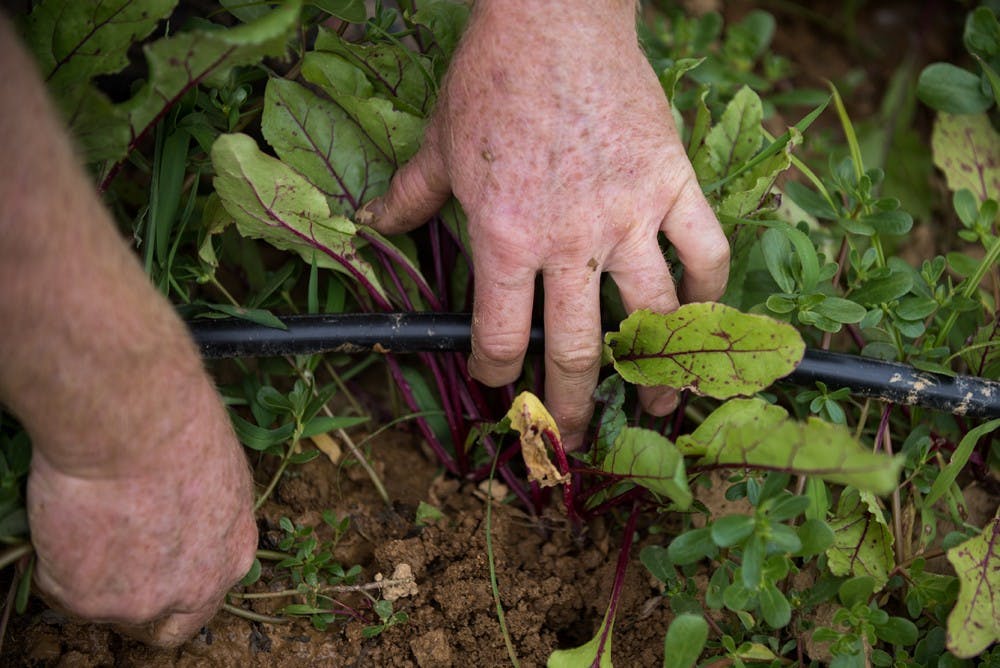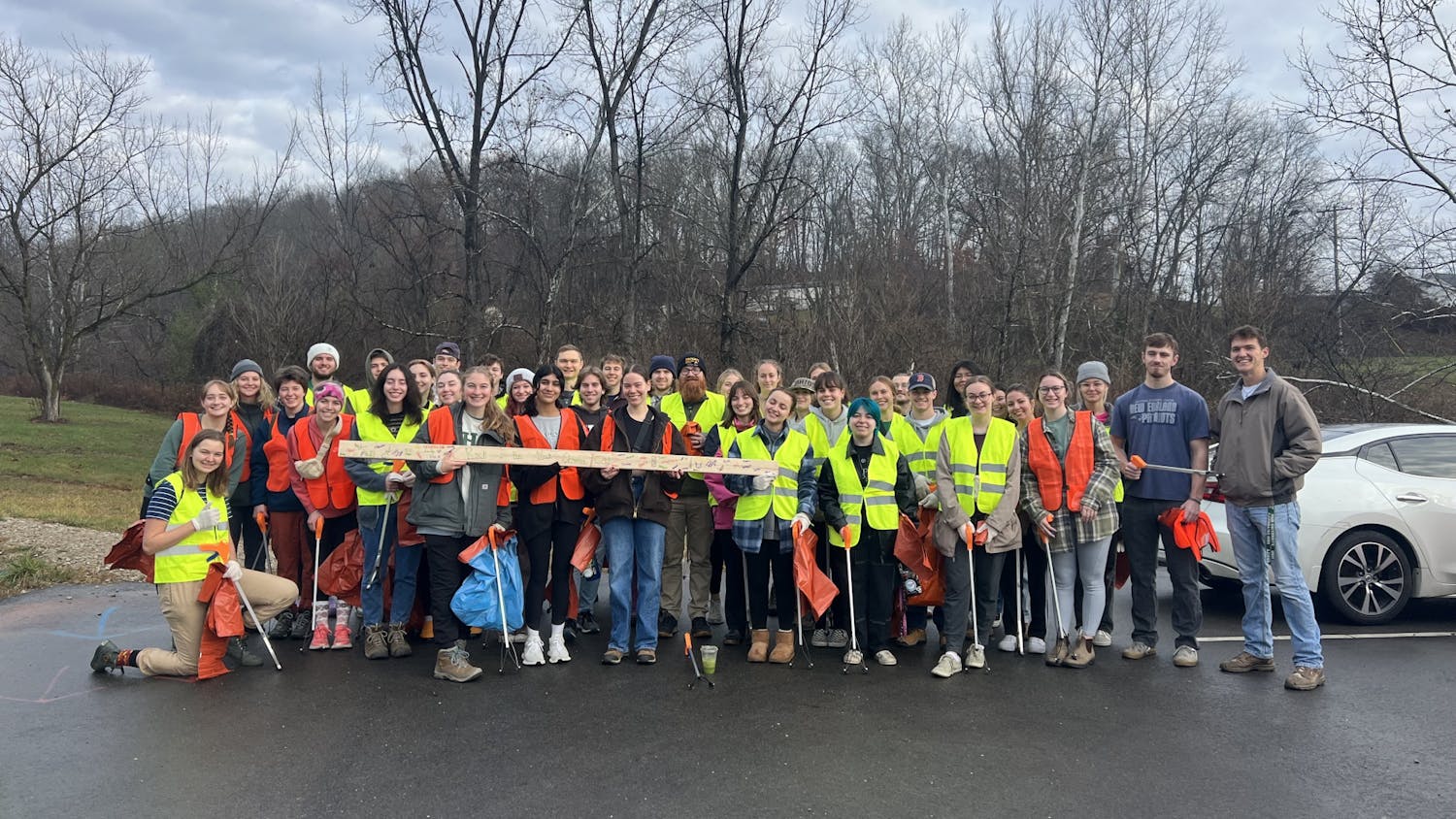Kip Rondy hasn’t made a profit from his farm since July.
Last year was hard because of poor weather, but this winter was unseasonably warm, and it should have helped profits rebound — but nothing changed.
“Sixty, 70 years ago, all these guys could make a living and send their kids to (Ohio University) on the back of 30 damn cows,” Rondy, who co-owns Green Edge Gardens in Amesville with his wife, Becky, said.
Not anymore, Rondy said, and he’s not alone: Other small farms are struggling as well.
“We’re all in this boat together,” he said.
Rondy and other local farmers are in a bind between staying competitive and staying afloat while producing food for locavores.
Local focus
The word “locavore” refers to one who tries to eat only locally produced foods. According to locavores.com, the term was coined in 2005 by Jessica Prentice, co-creator of the Local Foods Wheel. She started a movement that year by calling for San Francisco residents to eat food grown within 100 miles of the city.
Athens has had an affinity for local food since before “locavore” was even coined, though. The Appalachian Center for Economic Networks, or ACEnet, was founded in 1985 and works with small businesses throughout Appalachian Ohio.
“We help food and farm entrepreneurs develop,” Leslie Schaller, ACEnet’s director of programs and business director at Casa Nueva Restaurant and Cantina, 6 W. State St., said. ACEnet, then known as Worker Owned Network, helped Casa Nueva open in 1985.
According to the Center for Urban Education about Sustainable Agriculture, the distance an average American meal travels from farm to plate is about 1,500 miles. ACEnet aims to lower that number to 30. The 30 Mile Meal, an effort of ACEnet and the Athens County Convention and Visitors Bureau, hopes to narrow locavores’ focuses even further.
“It’s ‘how do we provide more opportunities for farmers?’ ” Schaller said.
Locavore motivations
When Eric Hedin first arrived in Athens in 1978, there were no fast food restaurants, he said. Hedin, the owner of the Athens Do It Yourself Shop, 16060 Canaanville Road, still enjoys eating locally.
“It’s good to be self-sufficient,” he said. “There’s a joy to it.”
According to Schaller, there are several reasons to eat local.
“A lot of people (are drawn) to local food from an interest in health,” she said. “It’s fresher and more nutrient-rich.”
Dr. Vandana Shiva, a scholar, environmental activist and author, was in Athens on Monday to discuss local food, and she said she also believes the increased health benefits are important.
“The most affordable health care is good food,” she said.
Hedin and Schaller both noted a social aspect as another case for local food. Hedin cited what he called “the pride of the village,” or how supporting those around the area makes a person feel, while Schaller mentioned the Athens Farmers Market.
“It’s kind of a crossroads for people of every age, every income level,” Schaller said of the market.
The biggest reason to eat local foods cited by those experts, though, is the economic impact.
“People of all ages want to support their neighbors and communities,” Schaller said. “Buying local one time a day or one time a week can really help the local farmers. We all get to vote with our forks every day.”
Hedin believes local products are superior and thus more deserving of funding.
“Why should our money go to big companies when little people can make a better product?” he said.
One of the largest hurdles for ACEnet’s clients is competition with massive corporations, Schaller said.
“How do we differentiate from what a Wal-Mart or a larger-scale distributor might bring to the table?” she said.
Dollar dilemma
Rich Tomsu is 85 years old, and he remembers watching his grandfather produce his own food.
“At an early age, I realized that it was possible to grow your own food,” he said.
Years later, Tomsu bought his farm, Rich Gardens Organic Farm, in Shade.
“I realized, at a point in time when I wanted to change my life, (farming) is something I could do,” he said.
Nowadays, for unsubsidized farmers like Tomsu and Rondy, times are tough. In the past, farmers used to make a good living.
“I suspect that the original owner of my farm … had only 10 cows,” Tomsu said.
Statistics from the United States Department of Agriculture show a vast swing away from small farms. In 1935, there were more than 6 million farms in the U.S., with a mean size of less than 200 acres each. Now, there are just more than 2 million farms, each averaging about 400 acres.
Those farmers blame big agribusinesses, who, they say, receive most of the planned $23.9 billion in government farm subsidies.
“The problem is the economic disparity between (big farming businesses and small farm owners),” Rondy said.
Rondy said his employees make more than he does. After the employees are paid, hardly any money is left for him and Becky.
“It just gets so frustrating,” he said.
Likewise, Tomsu’s sole full-time employee makes more than the farm owner for whom he works.
“Sometimes … I don’t make anything at all, and certainly not even the minimum wage,” Tomsu said.
Rondy, Tomsu and other local farmers are struggling to compete with big corporations like Wal-Mart and Kroger.
“We’re creating two separate worlds in this one economy,” Rondy said.
Rondy also fears for the future of farming due to the rising cost of land.
“I bought my place 30, 40 years ago, and it cost $60,000 or $70,000, I can’t remember,” he said. “Now, we had it appraised at $400,000 — not including any of the infrastructure, the 10 greenhouses we built … just the land and the house and the barn.”
Rondy doubts that the next generation of farmers will be able to foot the bill for such an expense.
“How can they afford it?” he said. “They can’t finance that debt.”
Even if the debt of purchasing a farm is financeable, Tomsu doesn’t believe those hypothetical farmers would be able to pay it off.
“They’re still going to make, maybe if they’re lucky, $5 an hour,” he said. “What is the incentive to go into debt for hundreds of thousands of dollars if you’re going to be paying that debt and making $5 an hour? That just doesn’t make any sense.”
Fifty years ago, it wasn’t that way, Tomsu said, and farming was more profitable.
“I probably made as much money back then, maybe even more, than I’m making now,” he said. “That’s the irony.”
All hardships considered, Rondy will continue to wake up each morning and farm.
“This is very important work, and we just need to continue to do it, and maybe it’ll develop itself.”
Though the sale of his property would net him what he called a “fortune,” Tomsu does not plan to sell his farm anytime soon, even at the age of 85.
“I don’t want to do anything else (but farm),” he said. “I’ll probably continue to do this until I drop over one day in the field.”






